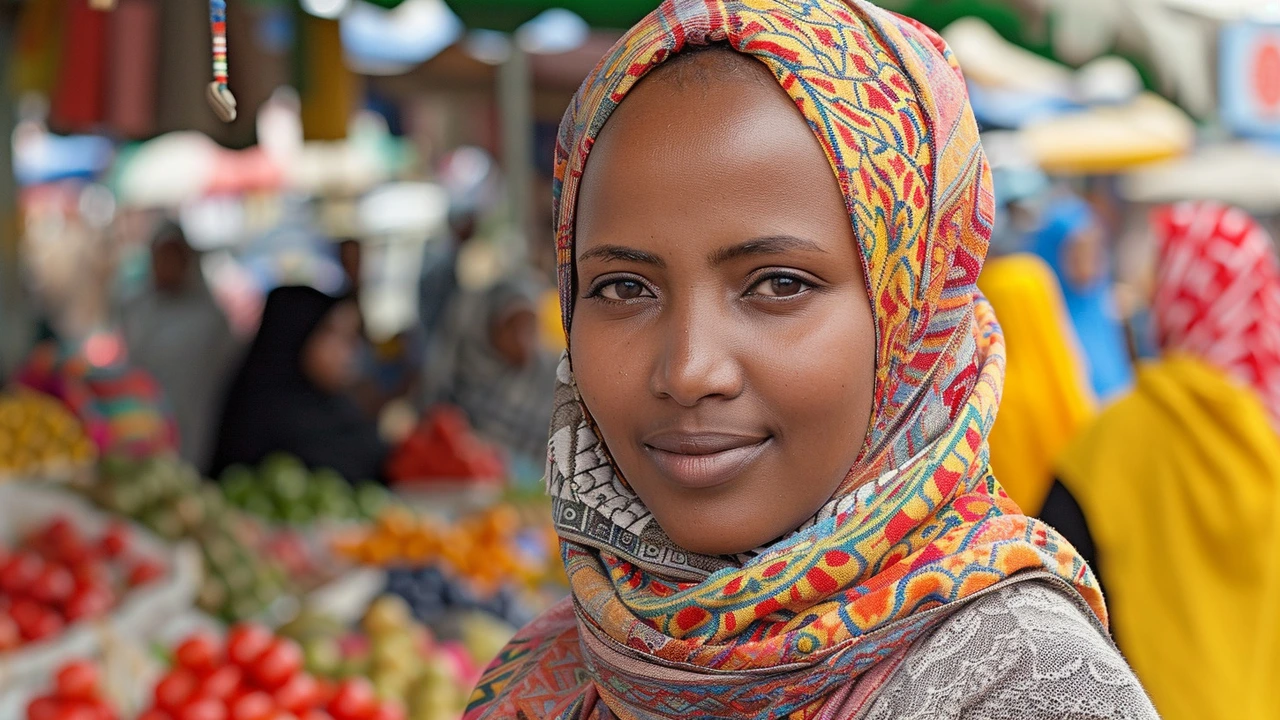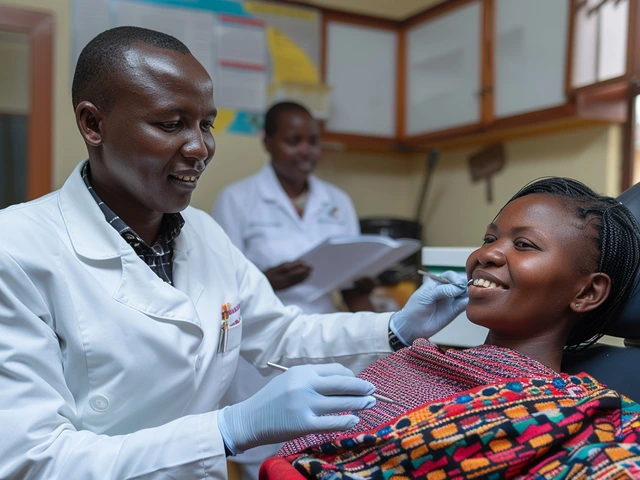Ethiopia has long been a land of intrigue and allure, known for its ancient history, stunning landscapes, and unique cultural heritage. Yet, despite these treasures, the nation faces significant economic challenges that have kept it classified among low-income countries.
The reasons behind Ethiopia's economic struggles are complex, stemming from a mix of historical events, reliance on agriculture, political and social issues, and the dynamics of foreign aid and investment. Understanding these factors is crucial for grasping the broader picture of Ethiopia's current economic status and considering the possibilities for its future growth and development.
- Historical Context
- Agriculture and Economy
- Political and Social Factors
- Foreign Aid and Investment
- Pathways to Development
Historical Context
Ethiopia's history is a vast tapestry that stretches back thousands of years, making it one of the oldest nations in the world. It is home to the spectacular ruins of Aksum, a powerful ancient kingdom that once controlled vast territories in the Horn of Africa. The Aksumite Empire was a major player in trade, dealing in goods like gold, ivory, and exotic animals. Despite its early prosperity, the empire eventually declined, due to a mix of internal and external pressures.
The medieval period in Ethiopia was marked by the rise of the Solomonic Dynasty in the 13th century, which claimed descent from King Solomon and the Queen of Sheba. This era saw considerable centralization of power and the flourishing of Ethiopian Orthodox Christianity, leaving a legacy of churches and monasteries rich in history and art. However, the frequent conflicts with neighboring states and internal rebellions often strained resources.
In the late 19th and early 20th centuries, Ethiopia began to face external pressures from European colonial powers. One of the most iconic moments in its history came in 1896, when Ethiopian forces led by Emperor Menelik II defeated Italy at the Battle of Adwa, a rare victory for an African nation against a European power at that time. This victory secured Ethiopia's sovereignty but also isolated it as other African nations fell under colonial rule.
By the mid-20th century, Ethiopia was ruled by Emperor Haile Selassie, who sought to modernize the nation but faced significant challenges. The Italian occupation from 1936 to 1941 during World War II disrupted the country's attempts at development. After World War II, Ethiopia continued its modernization efforts under Haile Selassie, attempting to build infrastructure and improve education. Despite advancements, rampant poverty and uneven wealth distribution persisted.
In 1974, a significant turning point came with the overthrow of Haile Selassie by the Marxist Derg regime, which imposed a brutal communist rule. The Derg nationalized land and businesses, which initially aimed to address inequalities but ultimately led to economic stagnation and widespread famine. The regime’s policies exacerbated poverty and disrupted agricultural production, leading to crises that harmed Ethiopia's economy.
The fall of the Derg in 1991 ushered in a new era, but the legacies of past turmoil had lasting effects. Ethiopia's economic and political landscape remained deeply fractured. Decades of conflict, political repression, and economic mismanagement had left indelible marks on the nation's path to development. Understanding this history is crucial to grasp the complexities of Ethiopia's current low-income status.
"The history of Ethiopia is not merely a chronicle of wars and hardships, but a testament to the resilience and perseverance of its people," wrote historian Bahru Zewde.
It’s a nation with enduring strength, yet one cannot ignore the historical elements that have repeatedly drawn it into cycles of struggle. Recognizing these elements allows for a better examination of what strategies might help Ethiopia overcome its economic challenges and pave the way for a more prosperous future.
Agriculture and Economy
Ethiopia's economy has long been anchored by agriculture, a sector that employs nearly 70% of the population. Despite the expansive engagement in farming, the sector faces numerous challenges that hinder its potential. Dependence on traditional farming techniques, unpredictable climatic conditions, and limited access to modern technology are significant barriers. Much of Ethiopian agriculture remains rain-fed, making it highly vulnerable to droughts and other climatic variations. This volatility contributes to the nation’s low productivity and income instability among farmers.
A crucial aspect worth noting is the focus on subsistence farming. Many Ethiopian farmers grow crops primarily for their own consumption, with little left over for commercial purposes. This approach limits the potential for economic growth within the sector. Cash crops like coffee and oilseeds do contribute to export earnings, yet the reliance on these commodities exposes the economy to global price fluctuations. When prices fall, so do the income levels of those dependent on farming these crops. This cyclical vulnerability entrenches the population in a cycle of poverty.
Government Efforts and Agricultural Policies
Over the years, the Ethiopian government has made varied efforts to boost the agricultural sector. These include implementing development policies and establishing agricultural research institutions to introduce better farming practices. While these efforts have shown some positive results, substantial challenges remain. The infrastructure needed to support agriculture, such as roads and irrigation systems, is still underdeveloped, restricting farmers' ability to access markets and resources.
Access to credit and financial services is another significant hurdle. Many farmers lack collateral, making it difficult for them to secure loans that could be used to invest in better equipment or seeds. Without these improvements, productivity remains low. The Ethiopian government has collaborated with international organizations to enhance financial inclusion, but the impact has been gradual and unevenly distributed across regions.
“Agriculture is the backbone of the Ethiopian economy, but it needs more modern approaches to truly flourish,” says Dr. Getahun Mekonnen, an agricultural economist at Addis Ababa University.
Smallholder Farms and Rural Development
Smallholder farms dominate Ethiopian agriculture. These small-scale farms can be productive, but they face limitations due to their size and the resources available to them. Many of these farmers rely on manual labor and traditional tools, which are far less efficient than modern agricultural machinery. Although initiatives aimed at mechanization and the introduction of improved seed varieties exist, they often do not reach the most remote or poorest farmers, who need them the most.
Improving rural infrastructure can play a fundamental role in enhancing the agricultural sector. Better roads, electricity, and water supply systems will help farmers transport goods efficiently, store perishable items safely, and irrigate crops more effectively. Despite significant investments in these areas, many rural communities still lack basic infrastructure, hindering their ability to improve agricultural productivity significantly.
Climate Change represents another significant risk to Ethiopian agriculture. Changing weather patterns and increasing temperatures can reduce crop yields and alter growing seasons. To combat this, strategies such as sustainable agricultural practices, drought-resistant crop varieties, and water conservation methods are being explored and implemented. However, widespread adoption of these practices is still a work in progress.
The potential for economic growth through agriculture in Ethiopia is evident, but realizing this potential requires addressing these multifaceted challenges. By adopting modern techniques, improving access to financial resources, and enhancing infrastructure, the sector can become more resilient and productive. The Ethiopian government, along with international partners, must continue to focus on these areas to drive sustainable growth and improve the livelihoods of its agricultural workforce.

Political and Social Factors
When it comes to understanding why Ethiopia remains a low-income country, political and social factors play a pivotal role. Over the decades, Ethiopia has experienced various forms of governance, each with its own impact on the country's economic status. The long-standing monarchy was succeeded by a communist regime in 1974 and eventually, Ethiopia transitioned to a federal republic in the 1990s.
One key issue is political instability. Frequent changes in government and internal conflicts have impeded long-term development strategies. For instance, the civil war between the Tigray People's Liberation Front (TPLF) and the central government, which flared up in 2020, has had devastating effects on lives, infrastructure, and the economy. This kind of turmoil disrupts daily life, hampers foreign investment, and drains resources.
In addition, Ethiopia's socio-political landscape is influenced by its ethnic diversity. Home to more than 80 ethnic groups, the country has faced challenges in balancing the needs and aspirations of these different communities. The ethnic federalism model, designed to give autonomy to various groups, has at times led to tensions and conflicts, impacting social cohesion and economic progress.
Poverty and inequality are also significant hurdles. A large portion of the population lives in rural areas with limited access to education, healthcare, and basic infrastructure. These challenges are compounded by rapid population growth, which puts an additional strain on resources. Inequality between urban and rural areas means that economic growth often benefits only a small portion of the population.
Corruption is another critical issue. Transparency International's Corruption Perceptions Index often places Ethiopia in a relatively low position, indicating that corruption is widespread. This erodes public trust in institutions, deters investment, and leads to inefficient use of public funds.
Despite these challenges, Ethiopia has shown resilience and potential. Efforts to improve governance, foster inclusivity, and invest in social services are underway.
"Economic and social development cannot be disassociated from good governance." — World BankSuch steps are essential for creating a stable and robust foundation for economic growth.
Foreign Aid and Investment
Foreign aid and investment play a crucial role in Ethiopia's economy, often acting as a double-edged sword. While aid and investment bring in much-needed resources and infrastructure, they can also foster dependency and create hurdles to sustainable growth. Over the past several decades, Ethiopia has received billions of dollars in aid from countries and international organizations. This assistance has been essential in addressing immediate needs such as food security, healthcare, and education.
One of the most well-known initiatives is the Millennium Development Goals (MDGs). Launched in 2000 by the United Nations, these goals aimed to address various dimensions of poverty by 2015. Ethiopia, being one of the focus countries, benefitted significantly. The aid contributed to vast improvements in areas such as maternal health and primary education. However, despite these advances, the overreliance on aid has led to some unintended consequences. It can create a cycle where the local economy struggles to gain independence, constantly leaning on external help rather than building internal capacity.
The investment landscape in Ethiopia is a mix of promise and challenge. On one side, Ethiopia has attracted significant foreign direct investment (FDI), particularly from countries like China. Chinese firms have invested heavily in infrastructure, including roads, railways, and telecom. Such projects have boosted the economy and created job opportunities. On the other side, these investments often come with strings attached, such as debts or conditions that can be hard to meet. For example, the Addis Ababa-Djibouti Railway, funded predominantly by Chinese loans, has put a significant repayment burden on Ethiopia.
According to the International Monetary Fund (IMF), Ethiopia's external debt stock stood at around $27.3 billion by the end of 2022, highlighting the challenges of balancing growth with financial sustainability.
Foreign aid and investment are essential, but they are not a panacea. For Ethiopia to move beyond being a low-income country, it must find ways to leverage this help more effectively. One approach could be to focus on attracting investments that foster local entrepreneurship and innovation. Creating policies that encourage local businesses to grow can make the economy more resilient. Additionally, investing in education and skills training can prepare the workforce for jobs beyond traditional sectors like agriculture.
Another useful strategy could be the development of Special Economic Zones (SEZs). These zones can attract foreign investors by offering favorable tax regimes and smoother regulatory environments while ensuring that the local workforce is trained and engaged in the projects. Such models have been successful in countries like China and Vietnam, contributing significantly to their economic rise. Ethiopia could benefit from adopting similar frameworks tailored to its unique context.
In conclusion, while foreign aid and investment are vital levers for economic growth in Ethiopia, they must be balanced with strategies that build local capacity and economic independence. By doing so, Ethiopia can break the chains of dependency and set itself on a path to sustainable, long-term development.

Pathways to Development
Ethiopia, with its rich cultural heritage and immense potential, stands at a critical juncture in terms of economic development. To overcome the barriers that have historically impeded progress, a multifaceted approach needs to be pursued. One of the foremost strategies is to improve agricultural productivity. Given that a significant portion of the population relies on subsistence farming, introducing modern agricultural practices and technologies can greatly enhance yields and reduce poverty. Investments in irrigation, fertilizers, and improved seed varieties are essential steps in this direction.
Another crucial area is infrastructure development. Better roads, reliable electricity, and modern communication systems can help connect rural areas to markets and spur economic activities. This connectivity can also attract foreign investment, which can be a game-changer for Ethiopia. Education also plays a pivotal role in economic development. Enhancing educational infrastructure and ensuring access to quality education can create a skilled workforce ready to participate in a growing economy. Emphasizing vocational training and higher education in fields like engineering, technology, and healthcare is particularly relevant.
Sustainable industrialization is another pathway. Establishing and nurturing manufacturing industries can lead to job creation and export-oriented growth. Ethiopia has already made strides with industrial parks, but these efforts need to be scaled up and diversified. Encouraging small and medium-sized enterprises (SMEs) can also stimulate economic growth. SMEs are often the backbone of a resilient economy, providing employment and fostering innovation. Policies that support entrepreneurs, such as access to credit and business development services, are vital.
The service sector, especially tourism, holds substantial promise for Ethiopia. With its unique cultural and historical sites, the country can attract tourists from around the world. Developing tourism infrastructure and marketing Ethiopia as a travel destination can generate significant revenue. Additionally, leveraging digital technologies can drive growth. The digital economy, including e-commerce and information technology services, offers new opportunities for innovation and economic participation.
Creating a more favorable business environment is essential. Simplifying regulations, combating corruption, and protecting property rights can make Ethiopia more attractive to both domestic and foreign investors. A stable political environment is also critical for development. Peace and security create an environment where economic activities can flourish, and investments can be made with confidence.
Finally, building strong institutions that can manage and implement development policies effectively is crucial. Transparent governance and accountability can ensure that the benefits of development reach all segments of society, reducing inequality. By focusing on these pathways, Ethiopia can transform its economic landscape and improve the living conditions of its people, unlocking its full potential.

 Dentist Salary in Ethiopia: Earnings, Insights, and Opportunities
Dentist Salary in Ethiopia: Earnings, Insights, and Opportunities
 Top Countries for High-Paying Pharmacist Jobs
Top Countries for High-Paying Pharmacist Jobs
 Why PayPal Isn't Available in Ethiopia: A Comprehensive Guide
Why PayPal Isn't Available in Ethiopia: A Comprehensive Guide
 Exploring the Wealthiest Regions of Ethiopia: A Closer Look at the Country's Most Prosperous Areas
Exploring the Wealthiest Regions of Ethiopia: A Closer Look at the Country's Most Prosperous Areas
 Exploring Ethiopia's Economic Backbone: Top Exports Driving Growth
Exploring Ethiopia's Economic Backbone: Top Exports Driving Growth
mark sweeney
May 26, 2024 AT 17:40People love to blame everything on history, but the real problem is mindset.
randy mcgrath
May 31, 2024 AT 20:30When you look at the agricultural dependence, it’s clear that without diversification the economy stays stuck. Smallholder farms are stuck in a cycle of low yields, and that ripples through every sector. Adding irrigation and better seeds could change that, but it needs consistent policy support.
Frankie Mobley
June 5, 2024 AT 23:19Ethiopia’s economic story reads like a cautionary tale about how history and policy intertwine. The Derg’s land reforms smashed private initiative, and the aftershocks still echo in today’s farm productivity. Even after the 1990s reforms, too many farmers remain locked into subsistence production, barely touching markets. Climate volatility adds another layer of uncertainty, turning good years into disaster quickly. Infrastructure gaps-especially in rural road networks-mean that surplus crops often never reach buyers. Credit scarcity forces farmers to rely on informal lenders, perpetuating a cycle of debt. The government’s push for industrial parks sounds promising, yet many of those zones lack the skilled workforce to attract high‑value investors. Foreign aid has funded hospitals and schools, but it also creates a dependency that can stifle local entrepreneurship. Debt from infrastructure projects, like the Addis‑Ababa to Djibouti railway, has ballooned Ethiopia’s external liabilities. Political instability, particularly the recent Tigray conflict, has scared away potential investors and disrupted supply chains. Ethnic federalism, while meant to empower regions, sometimes fuels competition over resources rather than cooperation. Corruption remains pervasive, draining public funds that could otherwise go to critical sectors. Education reforms have expanded primary enrollment, yet secondary and vocational training still lag far behind demand. Meanwhile, urban migration swells cities without adequate housing or services, creating new social pressures. The diaspora’s remittances provide a lifeline for many families but also mask deeper systemic weaknesses. Digital adoption is picking up, but broadband penetration stays low in rural areas, limiting access to modern market information. Finally, without a clear, long‑term development strategy that balances aid, investment, and local capacity building, the country will keep swinging between growth spurts and setbacks.
ashli john
June 11, 2024 AT 02:09It’s awesome to see how much potential Ethiopia has, especially when you think about the youth ready to innovate.
Kim Chase
June 16, 2024 AT 04:58Totally agree with the point about infrastructure-roads are the veins of any economy, and Ethiopia’s need a serious upgrade.
David Werner
June 21, 2024 AT 07:47Behind the aid narrative lies a hidden agenda: powerful nations use Ethiopia as a pawn to secure resources while keeping the local population dependent.
Paul KEIL
June 26, 2024 AT 10:37From a macro‑economic perspective, the current balance of payments is vulnerable due to overreliance on a narrow export basket and external borrowing pressures.
Horace Wormely
July 1, 2024 AT 13:26The previous comment should have used “balance‑of‑payments” with a hyphen; also, “overreliance” is one word.
christine mae cotejo
July 6, 2024 AT 16:16The cultural richness of Ethiopia isn’t just a tourism hook; it can be leveraged for creative industries that generate export revenues. Think of music, film, and traditional crafts meeting global markets through e‑commerce platforms. When artisans get fair‑trade agreements, they keep more profit, which circulates locally. Additionally, partnering with diaspora entrepreneurs can open channels for knowledge transfer and investment. The government could set up incubators focused on cultural tech, blending heritage with modern design. Also, tourism infrastructure-like eco‑lodges and heritage trails-needs community ownership to ensure benefits stay local. If the tourism sector expands responsibly, it can fund conservation of historic sites while creating jobs. Combining these approaches could diversify income sources beyond agriculture, reducing vulnerability to climate shocks. It’s a long road, but the foundation is already there, waiting for coordinated policy action.
Douglas Gnesda
July 11, 2024 AT 19:05For anyone looking into Ethiopia’s development, start by examining the agricultural value chain; bottlenecks there affect the whole economy.
Abhijit Pimpale
July 16, 2024 AT 21:55Good point-value‑addition is crucial, especially for coffee and oilseeds.
Eric DE FONDAUMIERE
July 22, 2024 AT 00:44Energetic shout‑out to all the NGOs making strides in rural electrification-keep the momentum going!
Pauline Herrin
July 27, 2024 AT 03:33While optimism is commendable, the data on corruption indices suggests we must remain cautious about over‑promising reforms.
pradeep kumar
August 1, 2024 AT 06:23The debt figures are alarming; sustainable financing should be a priority.
love monster
August 6, 2024 AT 09:12Absolutely, transparent debt management can attract quality investors who care about long‑term impact.
Christian Barthelt
August 11, 2024 AT 12:02Contrary to popular belief, foreign aid isn’t the main cause of low growth; domestic policy failures play a bigger role.
Ify Okocha
August 16, 2024 AT 14:51It’s obvious that the elite just want to keep the status quo, using rhetoric about “development” to mask exploitation.
William Anderson
August 21, 2024 AT 17:40While that’s a harsh take, the evidence of uneven resource distribution supports the claim.